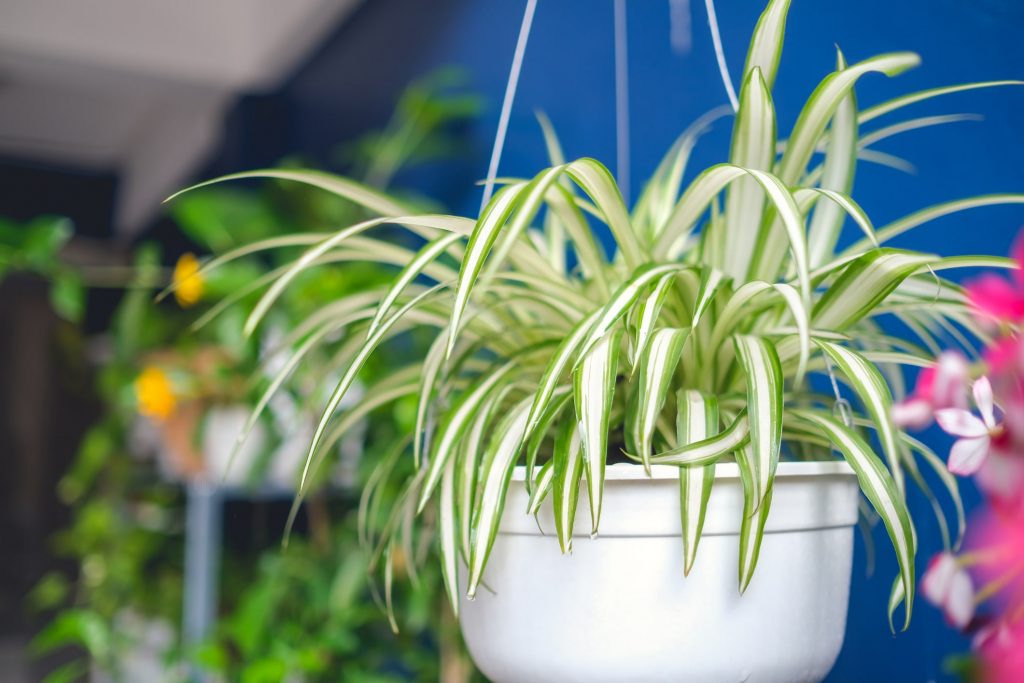If you enjoy taking good care of your gorgeous houseplants as much as I do, here’s a guide on how to arrange indoor plants and create a lush, natural space.
If you’ve been wondering how to arrange indoor plants at home, look no further. This guide is packed with imaginative ways to display your favorites. Decorating your home with plants can help bring nature indoors and create a warm and inviting interior – all at a bargain.
Keep reading to discover all the indoor plants arrangement ideas you’ll ever need. I’ll be covering tips on how to group your plants, how to use your plants to complement your existing decor and much more. So let’s delve into living room plant decor! Here are my 10 golden rules for houseplant arrangements at home.
Table of Contents
How to Arrange Plants in a Living Room: 10 Golden Rules
1. A Sunny or Shady Spot?
When deciding how to arrange your indoor plants, you have to first consider the needs of each plant, particularly when it comes to sunlight!
Does your plant need a sun-drenched spot, or would it prefer a more filtered source of light? Many species – such as Calathea Orbifolia, Tradescantia Nanouk or Ficus Tineke need dappled or indirect sunlight to thrive. Too much, though, can scorch the leaves of some species.
Before you place that plant, find out what its sunlight requirements are. For example, a snake plant that requires full sunlight might well fare best on that south-facing, sun-kissed window sill.

2. Perfect Plant Partners
The next thing to think about is how to group your plants. We suggest grouping plants in pairs as that can create a nice symmetrical effect. To group plants in pairs, it’s best to pick plants that are similar in appearance and height, leaving a gap between them for the full mirror-image effect.
Three plants work best, though, when the heights differ. For either of these groupings, try to choose plants that show some similarities in appearance for a harmonious look.

3. Picking the Right Pots
Using the right pots can help create a unique yet coordinated look. As with each plant’s need for sunlight, the type of pot needs to be taken into account. Think about whether or not you need drainage holes and a saucer for excess water.
Picking out pots in neutral hues means brings out the nature theme and matches easily with any kind of decor. You can’t really go wrong with neutrals, natural tones or terracotta.
As with the plants themselves, pots that are very similar work well when displayed in pairs. For a trio, try using colors and textures that are different, yet complement each other pretty well. Pots of differing heights can also look great. Taller containers are ideal for adding a touch of drama, for instance.

4. Pointing the Way
Does your living room have a unique feature? Or perhaps you’ve invested in some artwork for the walls? If this is true of your personal space then plants really can help you make the most of this.
Look carefully at the direction the foliage grows in. Leaves that point skywards can draw attention to a roof window, for example. Trailing plants, meanwhile, are good for drawing the eye to that geometric parquet floor.
Good examples of vining plants to go for include philodendron and pothos. They will grow downwards, subtly highlighting that vibrant rug, tiled hearth or polished wooden floorboards.
Snake plants work well when you want to highlight something above eye level. There are lots of species to choose from, and they’re easy to grow. Even for complete houseplant beginners.

5. Buying a Balance of Plants
I’m always on the lookout for new houseplants (guilty as charged!), but I always make sure to think about where I can display the houseplant in my space before buying it.
When shopping for fresh additions to your collection, consider how they might work with your decor. Plants that are distinctive in appearance or color can add interest to a minimalist setting.
On the other hand, homes that are already awash with lots of texture and detail may benefit from adding a few fairly plain plants. Big, glossy leaves in one shade – such as those of the Swiss cheese plant – will work well pretty much anywhere.

6. Think About Color
Color can have a huge impact when it comes to home decor. If you have a neutral home, then you can go wild when it comes to bright plants and pots!
Color isn’t only confined to the pots though. Even when they’re green, foliage can vary in shades of green. Pick between a pastel tone, a zingy lime, a deep shade or a grassy hue.
Why not try adding some pink plants if your living room could do with a splash of color? (Some of these look too good to be real, I know, but I can assure you that they really are genuine pieces of flora!)
If you like to nurture flowering plants, then the sky’s the limit when it comes to color. Just bear in mind how each plant will look when it’s not in bloom. As that may apply for most of the year, it’s an important consideration.

7. Get Off the Floor
Do you want to show off lots of glorious foliage or flowers without giving up floor space? Then you need to take a look at all the plant shelves that are available to buy!
There are free-standing tiered units, wall shelves with brackets, rolling furniture you can easily move around, floating shelving and even hanging pots. Find 20 of the best plant shelves in this post.

8. Growing Plants in Water
Another way to display plants is in clear glass containers. This only works, of course, with those species that can be grown this way. You can find a list of 10 plants that thrive in water here.
It’s actually surprisingly easy to grow plants in water, take it from me! I also love the way they look. Your friends and family will also adore you for providing them with a home grown version of that plant they’ve always admired!
Showing off your plants that are thriving in water is a great way to give your living room a singular look. The glass containers also add a contemporary edge – and reflect light for a fresh feel.

9. Choose What You Love
If you have a favorite houseplant species, then of course you’re going to want to show that off. Pick a piece or fauna you truly love and you’re not going to mind giving it a little TLC now and then. It’s all about nature and mindful living, and most of us could do with a little more of that.
If you adore a plant, then you will find a space for it. In your home as well as your heart! Take it from me, though – buying lovely plants can be seriously addictive.

10. Experimentation is Key
Don’t just take my word for it. It’s your home, so always go with what works best for you. If you like how an arrangement looks, then go for it. The final rule is that there are no rules.
The only golden rule that really matters is to take care of your plant’s actual needs for sunlight, water, humidity and so on. That’s why you should always start right there.

Final Thoughts on How to Arrange Indoor Plants
There really are so many ways to show off those well-tended houseplants of yours! Once you’ve taken care of each plant’s basic needs when it comes to matters like how much sunlight it needs, the only limit is your imagination.
Experimentation is always fun – as is picking out new plants to brighten up your space. As each living specimen grows, the look of your home will constantly be undergoing subtle changes too. Without you even having to lift a finger! I hope you’ve found my tips on how to arrange indoor plants useful!
Check out more of our plant care guides below:





This is the post I am looking for. I really need these tips. I am so horrible at decoration. Thanks a lot for the great tips.
I’m just going to put some flowers in my new apartment. I don’t know which one to choose yet. Will, for example, Hebe (a plant somewhat like a round hedge) also work well at home? It always grows into a ball, with small green leaves. I mean dense plants that are easy to grow.